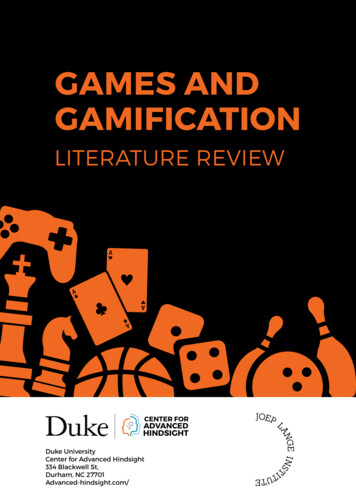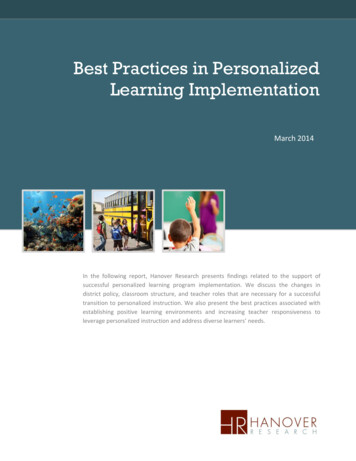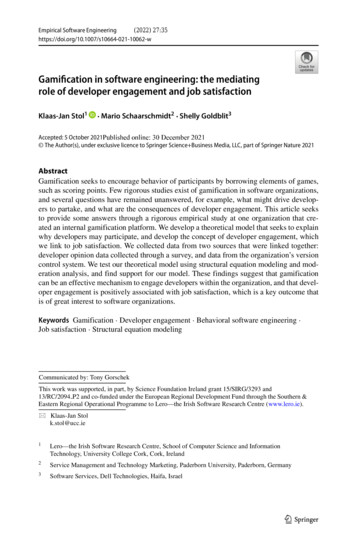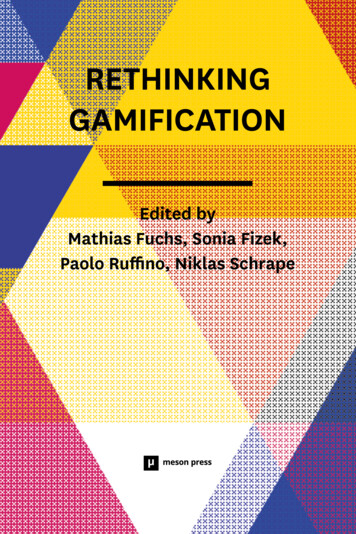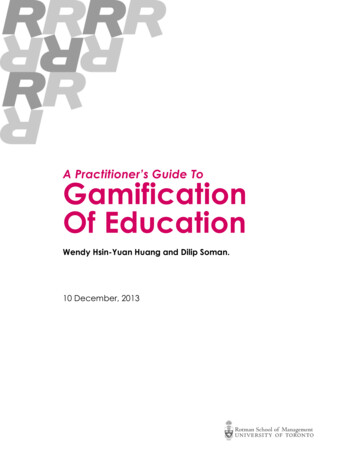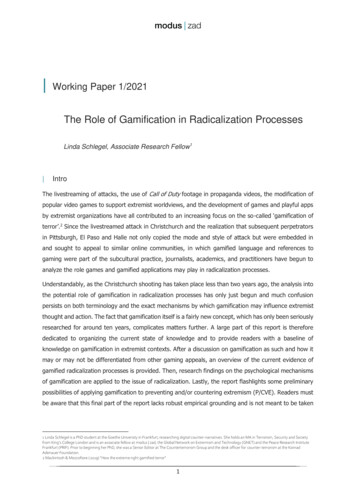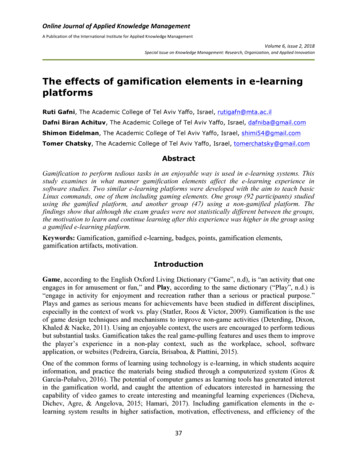
Transcription
IEEE TRANSACTIONS ON GAMES VOL.? NO.? MONTH ?Towards Personalized Adaptive Gamification: A MachineLearning Model for Predicting PerformanceChristian López and Conrad Tucker Member, IEEE Abstract—Personalized adaptive gamification has the potentialto improve individuals’ motivation and performance. Currentmethods aim to predict the perceived affective state (i.e., emotion)of an individual in order to improve their motivation andperformance by tailoring an application. However, existingmethods may struggle to predict the state of an individual that ithas not been trained for. Moreover, the affective state thatcorrelates to good performance may vary based on individualsand task characteristics. Given these limitations, this workpresents a machine learning method that uses task informationand an individual’s facial expression data to predict his/herperformance on a gamified task. The training data used togenerate the adaptive-individual-task model is updated every timenew data from an individual is acquired. This approach helps toimprove the model’s prediction accuracy and account forvariations in facial expressions across individuals. A case study ispresented that demonstrates the feasibility and performance ofthe model. The results indicate that the model is able to predictthe performance of individuals, before completing a task, with anaccuracy of 0.768. The findings support the use of adaptivemodels that dynamically update their training dataset andconsider task information and individuals’ facial expression data.Index Terms—Performance; Facial expression; Gamification;Machine learning.I. INTRODUCTIONGamification has emerged as a growing area of interestacross a wide range of sectors. In the past seven years,the research community has seen a significant growth ofpublications related to gamification [1], [2]. Deterding et al.define gamification as “the use (rather than the extension) ofdesign (rather than game-based technology or other gamerelated practices) elements (rather than full-fledged games)characteristic for games (rather than play or playfulness) innon-game contexts (regardless of specific usage intentions,context, or media of implementation)” [3, p. 14]. In otherwords, gamification aims to implement game features (e.g.,Manuscript received Xxxxxx XX, 20XX; revised Xxxxxx XX, 20XX;accepted Xxxxxx XX, 20XX. Date of publication Xxxxx XX, 20XX; date ofcurrent version Xxxxx XX, 20XX. This work was supported in part by theNational Science Foundation NSF-NRI #1527148 and NSF CHOT #1624727.C. López is with the Department of Industrial and ManufacturingEngineering, Pennsylvania State University, University Park, PA 16802 USA(e-mail: cql5441@psu.edu).C. Tucker is with the Department of Engineering Design, PennsylvaniaState University, State College, PA 16802 USA, the Department of Industrialand Manufacturing Engineering, Pennsylvania State University, State College,PA 16802 USA, and also with the Department of Computer Science andEngineering, Pennsylvania State University, University Park, PA 16802 USA(e-mail:ctucker4@psu.edu).Points, Leaderboards) in non-game contexts to encourageindividuals to perform a task or set of tasks (i.e., promoteaction or behavior) [4]. The tasks and objectives of a gamifiedapplication can vary based on the context of an application,and the designers’ intentions. For example, in the health andwellness context, physically-interactive gamified applicationssuch as Active Games, require individuals to use full-bodymotion to perform a physical task with the objective ofincreasing their physical fitness or improving their healthawareness [5].Due to the heterogeneity of individuals, researchers havestarted exploring methods to design personalized and adaptivegamified applications [6]. Current methods are oftendeveloped around studies that have explored the relationshipbetween individuals’ attributes and their game featurepreferences. However, these studies provide guidelines suitedfor a general demographic of end users and not for uniqueindividuals. Additionally, most of the existing gamificationmethods are not capable of dynamically capturing data of anindividual’s interaction with an application (i.e., real-time datacapture). Instead, these methods focus on gathering data indiscrete time intervals through the use of self-reportedquestionnaires [7]. This approach ignores the possibility thatindividuals’ attributes and preferences are dynamic in natureand could change over time [8], which could potentiallyimpact the long-term effectiveness of an application [9].The Affective Computing (AC) community has shown howindividuals’ facial expressions can be systematically capturedand used to improve their interaction with an application.Systems capable of capturing individuals’ facial expressionshave also shown to be suitable for personalization andadaptation [10]–[12]. In light of this, researchers have startedto increasingly implement AC methods to improve the userexperience in gaming applications [13]. These applications areknown as Affective Games, and are defined as games in whichthe “emotional state and actions of a player can be recognizedand used in order to alter the gameplot and offer an increaseduser experience” [14, p. 1]. Affective Games relateindividuals’ facial keypoint data to their perceived affectivestates. This affective state information is used to alter thegameplot or difficulty of the application in order to improvethe user experience. However, individual differences in facialexpressions can deteriorate the accuracy of existing methodssince they employ general models trained with datasets from alimited set of individuals. For these general models, it ischallenging to accurately predict the affective state of anindividual that it has not been trained for [15].Moreover, current Affective Games aim to recognizeindividuals’ affective states with the goal of improving their
IEEE TRANSACTIONS ON GAMES VOL.? NO.? MONTH ?experience and not necessarily their task performance, whichis a key aspect of gamified applications [16]. Studies haveshown that the relationship between performance and affectivestates is mediated by the task and individuals’ characteristics[17]. This relationship can limit the effectiveness of currentmethods in predicting an individual’s affective state andadapting an application to improve his/her performance.Therefore, designers should focus on developing modelscapable of predicting individuals’ performance, instead oftheir affective state. Furthermore, efforts should be taken todevelop models capable of systematically updating theirtraining dataset as new data of an individual is acquired andhence, adapting (i.e., learning) to an individual’s unique facialexpression characteristics.Given the current limitations, this work presents a methodto predict an individual’s performance on a gamified task (i.e.,tasks of a gamified application). The method enables capturingindividuals’ facial keypoint data in real-time without affectingtheir immersion in an application. Furthermore, the trainingdata used to generate the machine learning model iscontinuously updated each time new data of an individual isacquired. This continuous updating helps improve the model’saccuracy and account for variations in facial expressionsacross individuals. The method has the potential to enabledesigners to systematically quantify the correlation between anindividual’s facial keypoint data and his/her performance on agamified task. This information could potentially be used toadapt the game features and task difficulty of gamifiedapplications [18].II. RELATED WORKA. Personalized Adaptive GamificationResearchers agree that gamified applications should bedesigned from a highly personalized and adaptive point ofview since studies have shown that individuals interact withgamified applications in different ways [19]. As stated byBuckley and Doyle “individuals do respond differently togamification, based upon individual attributes” [20, p. 44].Even though researchers have begun to explore how differentgroups with common attributes (e.g., personalities, learningstyles) perceive and interact with gamified applications [20]–[23], several limitations still exist. First, these studies havefocused on gathering individuals’ data through the use of selfreported questionnaires, which can impact the validity of theresponses due to individuals’ biases [24]. Furthermore, thesestudies ignore the possibility that individuals’ attributes andpreferences are dynamic in nature and could change over time[8]. Not considering the dynamic nature of human behaviorand preferences can have a negative impact on theeffectiveness of gamified applications [9].Besides individual differences, the characteristics of a taskand the effort required to complete it can impact the effectsthat gamification has on motivating individuals to perform thetask successfully. The Fogg’s Behavior Model (FBM) [25]suggests that there are some fundamental tasks and individualcharacteristics that can impact the effectiveness ofgamification. For example, in the gamified applicationpresented by Denny [26], in which students generated andanswered multiple choice questions, their performance on thenumber of answers submitted and the number of active dayswas improved with the gamified application, compared to thecontrol group (i.e., non-gamified). However, there was nosignificant improvement in the number of questions generated.These results are in line with FBM since the greater effort andtime required to generate questions (i.e., greater taskcomplexity) impacted their motivation and performance onthat task. Furthermore, Lopez and Tucker’s [27] studysupports the need to consider task characteristics whiledesigning gamified applications. Their results reveal that therewas a negative correlation between the complexity of a taskand individuals’ performance.Similarly, the human-computer interaction community hasrecognized the connection between task properties andindividuals’ performance, and developed several predictivemodels of human performance [28], [29]. These models allowdesigners to evaluate the expected performance of individualswhile interacting with an interface, without having to test it.This is done by evaluating task information using modelsfounded on experimental psychology and information theoryresearch [29], [30], or in some cases, even machine learningmodels [31]. For example, Li et al. [31] used a deep learningalgorithm to predict the time individuals spend in a verticalmenu selection task. Their model achieved an R2 ranging from0.75 to 0.95 when tested with multiple datasets. However,while some of these predictive models do take intoconsideration individual characteristics (e.g., expert vs.novice) [30], [32], it is still challenging for them to customizetheir prediction on an individual level.Recently, a systematic literature review in the field ofadaptive gamification was presented [6]. The challengeshighlighted in this review illustrate the need for moreempirical studies and methods to advance gamifiedapplications. Moreover, the authors stated that machinelearning would play a significant role in advancing the field ofgamification. For example, Barata et al. [33] presentedevidence that suggests that machine learning algorithms canbe used to predict “student types”. In a previous study, theauthors identified four distinctive “student types” according totheir performance, engagement, and behavior on theapplication [34]. Their results revealed that after nine weeks ofinteracting with the applications, a participant’s performancedata could be used to predict his/her “student type” with anaccuracy of 0.79. A participant’s player type, along withhis/her performance data from a five-week period, was onlyable to predict his/her “student type” with an accuracy of 0.47.In recent years, researchers have started working ondeveloping methods for personalized adaptive gamifiedapplications with the goal of maintaining individuals’motivation for long periods of time [6]. These methods tend toimplement guidelines developed based on a generaldemographic of end users [35]. Hence, the degree ofpersonalization that they can provide to a unique individual islimited. Furthermore, some of this work only providesconceptual frameworks and little empirical evidence of their
IEEE TRANSACTIONS ON GAMES VOL.? NO.? MONTH ?implementation or feasibility [9], [36]. Finally, these methodsare not capable of systematically capturing data of individuals’interaction with a gamified application and predicting theirtask performance. Therefore, due to the limitations of currentmethods, this work presents a machine learning method topredict an individual’s performance on a gamified task. Themethod captures individuals’ facial keypoint data in real-timeas they interact with a gamified application without affectingtheir immersion. Moreover, a benchmark analysis on theperformance of the model, generated with multiple machinelearning algorithms, is presented. This model has the potentialto advance gamified applications by enabling designers toconsider task characteristics and individuals’ facialexpressions.B. Affective Computing, Affective Games, and GamificationIn recent years, researchers have started implementingAffective Computing (AC) methods with the objective ofimproving user experience in gaming applications [13], [14],[37]. AC researchers have been able to infer individuals’affective states by using a wide range of modalities, such asbody movements, speech, and facial expressions [38].Nonetheless, AC applications frequently use facial expressionsto infer an individual’s affective state [39]. This is becauseindividuals reveal a significant amount of affective stateinformation through their facial expressions [40].Additionally, facial expressions can be captured with sensorsthat do not affect an individual’s immersion or ability tointeract with an application [41]. For example, the AffectiveGame developed by Grappiolo et al. [42], capturedindividuals’ affective state information via facial expressionsand the use of self-reported questionnaires. The applicationused this information to adapt and change its content toimprove user experience. Similarly, Shaker et al. [43]presented an Affective Game that was capable of adapting itsgame features and task complexity (i.e., level difficulty) basedon individuals’ predicted affective states [44], [45]. In adifferent approach, Athanasiadis et al. [46] incorporatedstudents’ scores to predict their “energy function” value (i.e., afunction of self-reported engagement, boredom, andfrustration levels) in an educational application, indicating thatstudents’ performance was associated with their affectivestate. Similarly, others studies have shown a link betweenindividuals’ affective state and their task performance,especially in cognitive tasks [47]–[49]. However, researchindicates that the affective state that correlates to goodperformance may vary based on the characteristics of the taskand individual [17]. Hence, current applications might adaptbased on an individual’s affective state, and not observeimprovements in his/her performance.Table I shows a summary of existing methods thatresearchers have developed to personalize their gamified andnon-gamified applications. Most of the methods developed forgamified applications tend to capture individuals’ data atdiscrete times via self-reported surveys. In contrast, AffectiveGames have shown how designers can dynamically captureindividuals’ data (e.g., facial keypoint data) to predict theiraffective states. However, most of the current affect-sensitivesystems employ general models [14]. The accuracy of thesesystems might be impacted by the heterogeneity ofindividuals’ facial expressions [50]. As shown by Asteriadis etal. [44], their “player dependent” model (i.e., individualmodel) outperformed their general model in terms ofaccurately predicting individuals’ engagement (i.e., accuracy:0.71 vs. 0.82). Moreover, existing methods do not update theirmodel’s training set dynamically as new data of an individualof interest is acquired. The capability of models todynamically adapt to individuals has great potential toadvance personalized systems [15].TABLE ILITERATURE REVIEW SUMMARYStudy[43], [46][7], [12], [39], [42],[44], [45], [51][9], [21], [22], [24],[33], [35], [36],[52]This workDynamicDataCapture aNoYesXXXGamifiedApplication bNoXYesXXXXAdaptiveIndividualModel cNoYesXXXXaData captured dynamically as individuals interact with an application (i.e.,facial expression, gestures, voice), not at discrete points in time (i.e., selfreported questionnaires after or before interacting with the application).bNot a full-fledged game intended just for entertainment purposes, but agamified application intended to promote action or behavior.cImplements a model that systematically updates its training set as new dataof an individual of interest is acquired; hence, adapting to a uniqueindividual’s characteristics (unlike general models).Furthermore, current affect-sensitive systems tend to groupindividuals’ affective states into discrete categories or a singlefunction value of their affective states (e.g., engagement, fun,frustration, “energy function”) [24], [43], [46]. However,individuals’ affective state is far more complex andheterogeneous. The assumption of a “one-to-onecorrespondence” between the expression and the experiencedaffective state of an individual may limit the effectiveness ofexisting systems [40]. Thus, potentially affecting theiradaptability to improve and maintain individuals’ motivationand performance over time. Recent studies reveal thatindividuals’ facial keypoint data and machine learning modelscan be used to bypass the need to group individuals’ affectivestates into discrete categories and predict their performance ona task [12]. For example, a machine learning model that usesstudents’ facial keypoint data captured while reading theinstructions of an engineering task, was shown to accuratelypredict their task completion time [51]. Therefore, in thiswork, a machine learning method to predict individuals’performance, instead of their affective state, is presented.Specifically, an adaptive-individual-task model to predict anindividual’s performance on a gamified task by using his/herfacial keypoint data and task information is presented. Themethod captures facial keypoint data in real-time as anindividual interacts with an application. Furthermore, themethod updates the model’s training set every time new dataof an individual is acquired. The results of this work support
IEEE TRANSACTIONS ON GAMES VOL.? NO.? MONTH ?the implementation of facial keypoint data and adaptiveindividual-task models as a potential method to advancegamification.IV.A.IV.A. DataData AcquisitionAcquisitionIII. RESEARCH QUESTIONSIV.A.2. FacialKeypoint DataAs highlighted in [6] there are many open researchquestions and challenges in the field of personalized adaptivegamification. Previous studies have shown that machinelearning models that implement individuals’ facial keypointdata, captured while reading the instructions of a task, canaccurately predict individuals’ task completion time [51].However, there is a need for more empirical evidence tosupport the benefits of implementing machine learningmethods to advance the field of gamification. The objective ofthis work is to bridge the current knowledge gap by exploringfundamental research questions that will provide quantitativeevidence in support of implementing facial keypoint dataacquisition and machine learning models to predict anindividual’s performance in a gamified application. In thiswork the following research questions are addressed:RQ1. Can a machine learning model predict theperformance of an individual on a gamified task with accuracygreater than random chance by using his/her facial keypointdata and task information?Addressing this question will reveal that a machine learningmodel can predict an individual’s performance on a gamifiedtask, with accuracy greater than random chance. Nonetheless,a machine learning model that is trained with data from alimited set of individuals (e.g., general model) will not be ableto consider the unique characteristics of a new individual’sfacial keypoint data. Therefore, the authors propose anadaptive-individual-task model capable of updating itstraining set as new data of an individual is acquired.Consequently, this motivates the following question:RQ2. How does an adaptive-individual-task model’sperformance change as new data of an individual is acquiredand the model is re-trained?To address RQ2, the adaptive-individual-task machinelearning model is validated with an iterative cross-validationapproach that simulates scenarios in which new data of anindividual is acquired. This adaptive process helps account forvariation in facial expressions of individuals; hence, enablingthe model to adapt (i.e., learn) to an individual’s unique facialexpression characteristics.IV. METHODThis section introduces a machine learning method topredict an individual’s performance on a gamified task (i.e.,tasks of a gamified application). Figure 1 presents the outlineof the method that includes the Data Acquisition (IV.A) ofTask data (IV.A.1), individuals’ Facial Keypoint data(IV.A.2), as well as Performance data (IV.A.3). Moreover, themethod has a Model Generation (IV.B) and a ModelValidation (IV.C) steps.IV.A.1. Task DataIV.B. ModelGenerationIV.C. ModelValidationIV.A.3. PerformanceDataPerformance PredictionFig. 1. Method OutlineA. Data AcquisitionThe purpose of this step is to systematically capture anindividual’s facial keypoint data before performing a gamifiedtask, as well as task and performance data. This data is used togenerate the adaptive-individual-task model and predict theperformance of individuals in a gamified task.1) Task data: The efforts required to complete a task canimpact the effectiveness of gamification in motivatingindividuals to perform the task successfully. Hence, theadaptive-individual-task model uses as input, data pertainingto the task, as well as data pertaining to individuals.Specifically, the model uses task complexity data as input.Task complexity is frequently modeled with three differentapproaches (i) subjective, which considers an individual’spsychological state, (ii) objective, which considers taskcharacteristics and properties, and (iii) an integration of thetwo approaches [53]. However, subjective approaches arechallenging to implement since their reliability is impacted byindividual differences [54]. For example, a math student mayperceive complex mathematics problems easy to solve but onthe other hand, may perceive aerial work hard. However,individuals with different backgrounds (e.g., constructionworkers) may perceive the complexity of these tasksdifferently. Therefore, in this method, a task complexitymetric that considers task characteristics and properties isimplemented.Depending on the gamified task (e.g., cognitive task,physical task), different methods that consider taskcharacteristics and properties can be used to measure taskcomplexity (see [27], [54], [55]). For example, Wood [55]proposed a complexity model that described tasks according tothree elements: (i) information cues, (ii) products, and (iii)acts. Information cues are stimuli that are used to makeconscious discriminations. While, products are quantifiableoutcomes of acts, and acts are the required steps for creatingthe product. Based on these elements, the model defines taskcomplexity as a function of (i) dynamic complexity, (ii)component complexity, and (ii) coordinative complexity.Dynamic complexity relates to the variability between taskinputs and products over time (e.g., game rules changing overtime). Component complexity relates to the number of actsneeded to complete a task (e.g., steps required to complete atask). Coordinate complexity relates to the strength betweenacts, products, information cues, and task inputs (e.g., tasksrequiring greater dexterity to perform) [17]. Similarly, in the
IEEE TRANSACTIONS ON GAMES VOL.? NO.? MONTH ?Fig. 2. Actors illustrating a set of Actions Units, from Ref. [56]context of gamification, Lopez and Tucker [27] proposed atask complexity metric to evaluate the physical effort requiredto perform a task in physically-interactive gamifiedapplications based on the body movements required toperform it (see section V.A.1) .2) Facial Keypoint data: Facial keypoint data is utilized sinceit can be captured without affecting an individual’s immersionor ability to interact with an application. In this work, a nonwearable sensor is used to collect the facial keypoint data ofan individual i before performing a task t (Fit). In this work,the facial keypoint data is measured as a relative weight froman Action Unit (AU), ranging from 0-1. This facial keypointdata resembles the Facial Action Coding System [56], inwhich expert raters code the facial displays of an individual, asillustrated in Fig. 2. The method presented can also beimplemented with facial keypoint data measured as twodimensional coordinates from an image. Nonetheless, in sucha case, the facial keypoints need to be regularized andnormalized. This normalization can be done via a regularizedmean shift algorithm and an ordinary Procrustes analysis, as in[51], [57].In this work, the facial keypoint data of an individual iconsists of j independent facial keypoint time series (for j ϵ setof facial keypoints). These are collected while individual iinteracts with a gamified application App, after beingintroduced to the task t and before completing the task (for t ϵset of gamified tasks {T}, and App ϵ set of gamifiedapplications). Therefore, the facial keypoint data of anindividual i on a task t (Fit) is a matrix with n rows and jcolumns, where n denotes the length of the time series. Thelength of the time series depends on the duration of theindividual’s interaction with the gamified application beforeperforming the task and the frequency in which the data iscollected. For example, Fig. 3 shows a representation of anindividual’s facial keypoints q and k (i.e., AU q and k)captured before performing the tasks of an application (i.e.,t {1,2, T}). Assuming that the frequency of data capturedwas 10 frames/sec (i.e., 10Hz) and the tasks were performedevery 6 sec, the data captured will generate T matrices (i.e.,{Fi1, Fi2 FiT}) with 2 columns (i.e., q and k) and 60 rows(i.e., n 10 frames/sec x 6sec).Facial KeypointsvaluesFacial Keypoint qFacial Keypoint kFor q and k ϵ the set of facial keypoints1 0 0 1 2 θtask1-1 θtask1θtask2Time Axis [sec]S S Fig.3. Illustration of facial keypoints data acquisitionθtaskT3) Performance data: In gamified applications, the tasks aredesigned such that by successfully performing them,individuals will meet the objective of the application. Due tothis relationship, researchers have used individuals’performance on the gamified task as a proxy for measuringtheir performance in meeting the objective of an application.Therefore, in this work, the same approach is used. For thepurpose of this work, the performance of an individual i on atask t is assumed to be a binary variable, where:Yit 1, if individual i successfully performed a task tYit 0, otherwise.For, i ϵ set of individuals {I}t ϵ set of tasks {T}B. Model GenerationThe objective of this step is to build an adaptive-individualtask machine learning model to accurately predict theperformance of an individual i on a task t (i.e., Yit ). The modeluses as predictor variables, the mean and standard deviationvalue of an individual’s facial keypoint data captured beforeperforming a gamified task (i.e., Fμit ,Fσit ), the complexity ofthe task (i.e., PCt), as well as individual and applicationidentifier data (i.e., ID, App). In order to account for thedynamic nature of facial expressions, and based on previousstudies which suggest that reactions are evident in individuals’facial expressions just after one second of stimulus onset [58],the mean and standard deviation of individuals’ facialkeypoint data is calculated every second (i.e., a 1 second timewindow). Moreover, the model is first trained with a dataset ofa general population of individuals. Then, as new data of anindividual of interest is acquired, the training set is updated,and the model is re-trained. This approach allows mitigationof the “cold start” problem [59] since before an individualinteracts with an application, no prior information of thatindividual’s interaction with the application exists.In this work, multiple machine learning algorithms areimplemented to test their capability to generate a model thatcan accurately predict an individual’s performance on agamified task. Specifically, in this work, a LogisticRegression, Naïve Bayesian, Support Vector Machines,Random Forest, and a Neural Network classification algorithmare implemented. The performance and computationalresources required to train the model using these machinelearning algorithms are evaluated. These algorithms wereselected since they are frequently used in the AffectiveComputing community, and have different underlyingprocesses for generating classification models (e.g., modelbased, decision tree) [40], [60].C. Model ValidationFor the machine learning model to be viable, its accuracyand robustness need to be evaluated. In this work, a crossvalidation (CV) approach is implemented. A CV approachrequires the partitioning of the dataset into two sets: (i) atraining set, and (ii) a testing set. A model is trained using the
IEEE TRANSACTIONS ON GAMES VOL.? NO.? MONTH ?training set, while the testing set is used to validate themodel’s accuracy. First, to benchmark the different machinelearning algorithms and to address RQ1, a 10-fold CVapproach is implemented. In this approach, the dataset israndomly partitioned into 10-folds. In each of the
adaptive gamification was presented [6]. The challenges highlighted in this review illustrate the need for more empirical studies and methods to advance gamified applications. Moreover, the authors stated that machine learning would play a significant role in advancing the field of

